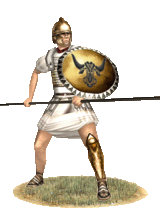On of the arts of ancient Greece was architecture. An example is the many temples they built. The temples had a religious purpose as well as political purpose. The Greeks developed three architectural systems, called orders, each with their own distinctive proportions and detailing. The Greek orders are: Doric, Ionic, and Corinthian. The Doric style was used in mainland Greece and the colonies in southern Italy and Sicily. The ionic style was fancier and was found in eastern Greece and the islands. The most elaborate of the three was the Corinthian style which was often seen on Roman temples.

Another of Greek's art was sculptures. One of the most important sculptures is the Charioteer of Delphi. It represents the balance between stylized geometric representation and idealized realism, thus capturing the moment in history when western civilization progressed forward to define its own foundations that braced it for the future.

Another of the Greek's sculptures is the Kouros. It was a man in a frontal pose with their left leg moved forward, their arms close to their bodies touching the side of their thighs.

Another of the Greek art was painting. They painted detailed pictures on the vases. The vases changed from place to place and from time to time. (Powell,80)
There were four periods of Greek art: the Geometric Period, the Archaic Period, the Classical Period and the Hellenistic Period. During the Geometric Period large-scale ceramic vessels were produced as grave markers. The first vessels had small portions filled with simple stick-figure people, often attending a funeral. The Archaic Period had two major types of art: vase-painting and sculpture. The vase painting was diverted from the Geometric Period and was the primary technique of Archaic vase-painting; It was known as the black-figure vase-painting technique. The statues of this time were made out of bronze and marble. They were often created for temples. The last Greece art period was the Classical Period. . In vase-painting, the technique changes from black-figures to red-figures, where the backgrounds are now painted in black, and the natural color of the red clay now represents flesh tones. Bronze sculpture was another major art form of Classical Greece. During this time another major event was the building of the Parthenon of Athens. These were the periods of Ancient Greece's art. The Hellenistic Period was the time in which Greek art was extended to their lands. The growth of violence was also extended in this time.

During these periods. there were no sharp changes in artistic style. There, however, was smooth changes between the art periods of Ancient Greece.
One effect of the changes in the periods of art was that the ancient greek artist were learning new techniques and addressing new problems. (Garland,199)
The Ancient Greek art gave birth to the western classical art. It also took influence in the Eastern civilizations and the new religion of Orthodox Christianity in the Byzantine era and absorbed Italian and European ideas during the period of Romanticism.
This is the basis for Ancient Greek art. It was very extraordinary and influenced many people and country in the years that followed.
Garland, Robert. Daily Life of the Ancient Greeks, Greenwood Publishing Group, Inc. United States, 1998.
Powell, Anton. Ancient Greece, Library of Congress Cataloging Publications, England, 1989.







